
Last year, I ran a D&D campaign set in and around a modern-day US high school. This post is just a dump of all my thoughts and some of the resources I made for the campaign. It’s intended to be browsed casually, not read from beginning to end.
Perhaps someone out there will find it interesting and/or useful. I hope so!
Structure
We had 16 sessions in total, over the six months from the 26th of June to the 18th of December. I had been inspired to return to D&D after watching CollegeHumor’s really excellent Dimension 20, and I thought that trying something with a similar structure could be fun.
One thing that I found really fascinating about Dimension 20 was the way they fully embraced the combat side of the game, by having every other episode be dedicated entirely to a combat encounter. Combat in RPGs tends to take a very long time, and my inclination had always been to try and skim over it as quickly as possible. Dimension 20 takes the opposite view: if combat is going to take a long time, let’s accept that, and make it as fun and dramatic as possible.
I think embracing combat is a really good choice if you’re set on playing D&D. So many of a character’s abilities are only relevant in combat that ignoring combat can mean ignoring many of the interesting decisions that a player makes as they level up.
Characters
We made the decision to start off with no one knowing anything about each other’s characters. The week before the first session, I spent an hour or two with each player, getting to know each character. This was so that I could build the story of the campaign around them.
(Yes, the idea of characters as somehow separate to the adventure; the idea of characters being able to slot into a pre-authored scenario with no modifications doesn’t make any sense to me.)
Here are the incredibly disorganised notes I took from those sessions:
Bueller
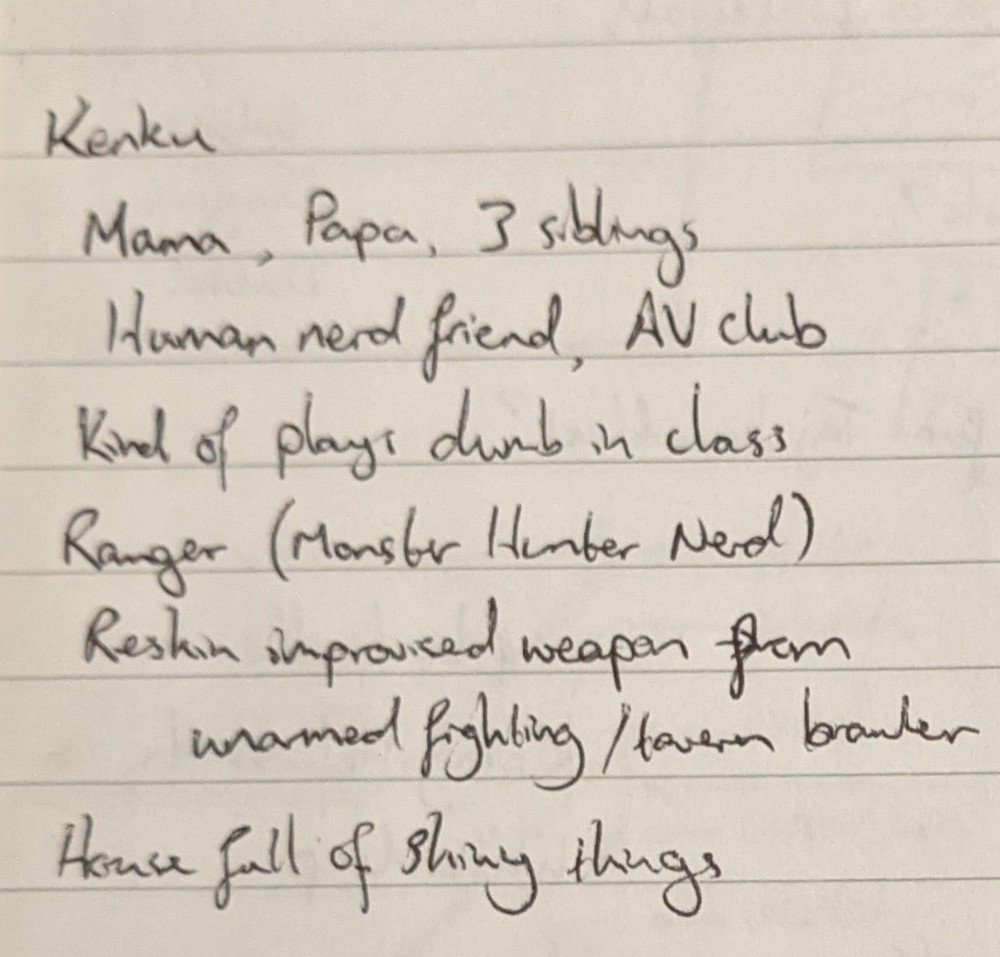
Bueller’s player decided that since Bueller was a kenku, a species who can communicate only through reproducing sounds they’ve already heard, Bueller would communicate exclusively in memes and pop culture references, which fit really well with his nerdy personality. I took inspiration from Bueller’s name and decided that it’s a common kenku tradition to name your children after your favourite film. The full names of the Santos family were
- 12 Angry Men Santos, “12”, mother, proprietor of a jewellery store
- Vertigo Santos, father, airline pilot
- Ferris Bueller’s Day Off Santos, “Bueller”, high school student
- Scarface Santos, Bueller’s younger sister, middle school student
- Bill Excellent Adventure Santos, “Bill”, Scarface’s younger brother, middle school student
- Ted’s Excellent Adventure Santos, “Ted”, Bill’s twin brother, middle school student
Amber

Amber was a popular cheerleader in the year above most of the other characters. She didn’t have a great deal going on to drive her character. Her main concern was with being popular, so I tried to bring her into the story through her relationships with other characters.
She ended up being sort of a chosen one – the source of all magic. There were references to this throughout the campaign, but I was far too stingy with clues and failed to remind the players of key details.
Sophie

Sophie’s player was the only American in the group. That “14–18” in the top right corner is a note I took while asking her about her character. It’s the age range of American high school students.
I was a little out of my depth running this campaign.
Sophie’s player had a great idea for a scene right off the bat. It actually ended up being the first scene of the campaign. Preparing for the first session involved looking at the WikiHow article for “How to Put Down a Horse”.
Hope

Hope’s player wrote several pages of backstory, which were a joy to read. She created several characters that became major characters in the campaign, as Hope’s foster family were aware of and involved with the magical world. More on them later.
Thanks to this backstory, I was able to run a one-on-one side-adventure with her by text, covering the time that passed in a session she missed.
Marlowe

It’s interesting that these are the only notes I have on Marlowe. I spent the longest time out of everyone with Marlowe’s player, as he came in with only a vague idea of what he wanted to do. But I left with such a strong idea of Marlowe’s character that clearly I didn’t feel the need to write anything down. He was a theatre kid. Not a bard, but a warlock who had made a pact with The Bard. He was also a fairy, which is a custom race that’s almost identical to the half-elf.
(His name was originally going to be Faust Marlowe, but his player swapped the names before the first session.)
Fairy Traits
Your fairy character has the following traits.
Ability Score Increase. Your Charisma score increases by 2, and two other ability scores of your choice increase by 1.
Size. Your size is Medium.
Speed. Your base walking speed is 30 feet.
Darkvision. You have superior vision in dark and dim conditions. You can see in dim light within 60 feet of you as if it were bright light, and in darkness as if it were dim light. You can’t discern colour in darkness, only shades of grey.
Fey Nature. You are considered fey instead of humanoid.
You have advantage on saving throws against being charmed, and magic can’t put you to sleep.
You only require 4 hours of sleep per day.
Skill Versatility. You gain proficiency in two skills of your choice.
If Music Be The Food. You do not need to eat or drink, though you may enjoy the pleasures of the material plane. Instead, you feed on the attention of others.
Whenever you make a successful Charisma check that delights others or places you in the spotlight, you gain Inspiration if you did not have advantage on the check.
Whenever you make an unsuccessful Charisma check, or embarrass yourself in public, the DM, at their option, may take Inspiration to use against you, or, if the failure was catastrophic enough, give you a level of Exhaustion.
There were other conditions, too – the usual fairy stuff: weakness to iron; inability to enter any place protected by a horseshoe; etc.
Ferris
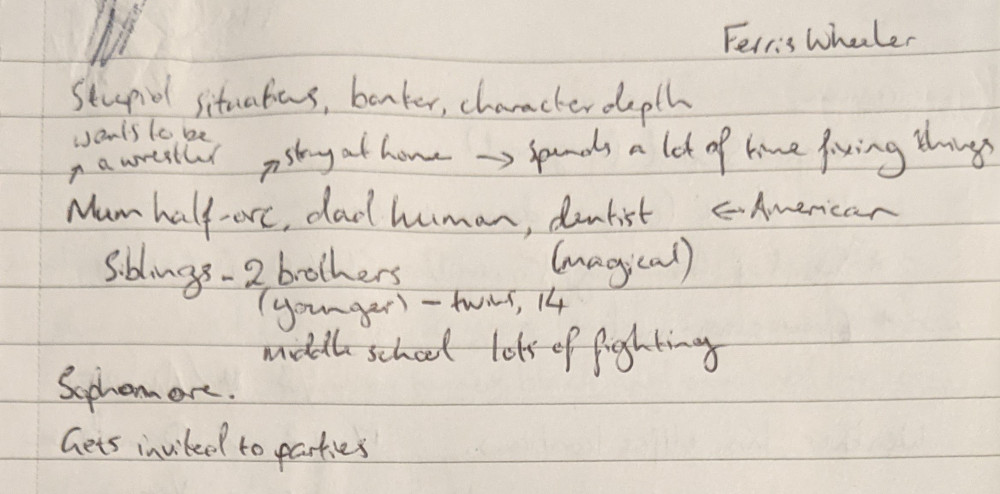
Ferris joined part-way through the campaign. I had him start at third level, like the other characters had. Hope gained an extra level during her side adventure. That meant that for a few sessions, the player characters spanned three levels.
It was absolutely fine; really not a big deal at all.
28/3/2021
Starting items
Each character started with at least one minor magic item.
Amber
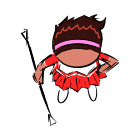
Baton of the Majorette
Staff, uncommon (requires attunement)
When you succeed on a save against an enchantment spell, you can use your reaction to turn the spell back on its caster as if you had cast the spell, using Charisma as your spellcasting ability. If the original spell targeted multiple creatures, the reversed spell only targets the caster. Other targeted creatures are still affected by the original spell. Once used, this property can’t be used again until the next dawn.
Bueller
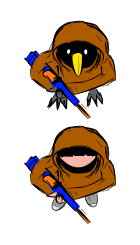
Hoodie of Hiding
Hoodie, common
While wearing this hoodie, you appear in your Human Form to all creatures that do not know your true form. This does not affect creatures that don’t rely on sight, as with blindsight, or can see through illusions, as with truesight. While wearing the hoodie, you can use your action to lower the hood, revealing your true form to anyone watching.
The hoodie also confers a +1 bonus to Dexterity (Stealth) checks made in urban environments.
Uncle Jimmy’s Nerf Rifle
Weapon (Nerf rifle), common
(range 150/600; 1d8 piercing damage; ammunition; heavy; two-handed)
This modified Nerf gun has a switch on the side that can be used to enable or disable its magical generator.
When switched off, the gun fires regular foam bullets, dealing no damage.
Ferris
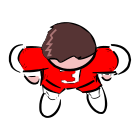
Wrestling Band-aids
Wondrous item, very rare
A very rare, limited edition set of novelty band-aids depicting famous wrestlers. You can use your action to apply one to a creature within 5 feet of you, immediately activating its effect. There are six left:
Meg Maniac. The target gains resistance to bludgeoning, piercing and slashing damage for one minute.
Wayne “The Wall” Dobson and Donna Prima. The target regains 3d6+6 hit points.
Mama Sheen and John D. Greatest. The target is immune to being frightened, and gains 5 temporary hit points at the start of each of its turns. This effect lasts for one minute, after which any remaining temporary hit points are lost.
The Doc. The target benefits from the effects of remove curse, lesser restoration and spare the dying.
Hope
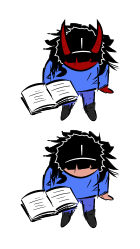
St Christopher’s medal
Wondrous item, uncommon (requires attunement)
While wearing this medallion, you appear in your Human Form as if under the effect of an alter self spell.
This item also has the following feature if attuned to by Hope Danvers:
I Will Fear No Evil. When you are targeted by an effect that causes you to make a saving throw to prevent becoming frightened, you can use your reaction and touch this medallion. If you succeed on the saving throw, you gain temporary hit points equal to the amount by which you succeeded. Alternatively, you can touch a creature within 5 feet of you, and they gain those temporary hit points instead. You can use this ability once. It recharges at dawn.
Marlowe
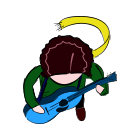
Marlowe’s Book of Shadows was a battered script. It was the script of his life, writing itself as he lived. His clothes were imbued with fey magic, granting them the properties of light armour (AC 11 + DEX) and making them resistant to dirt and tears.
His weapon was an acoustic guitar that counted as a two-handed finesse weapon for him and did magical bludgeoning damage (d8).
Sophie

Sophie’s Druidic Focus
A locket containing some of Poppy’s hair, and a poppy.
Once per day, you can use this item to cast the druidcraft cantrip.
This item also has the following feature if attuned to by Sophie Shadwell:
While wearing this locket, you have advantage on Animal Handling, History, Insight, Investigation, Medicine, Nature, Perception and Survival checks relating to horses.
Buttons
At one point, Sophie made buttons for all her friends. These had various effects that enhanced or augmented each character’s abilities. Most of them were existing traits from the 5th edition source books. Here are the details:
Amber’s button
Sophie Shadwell made this for you as a token of your friendship. While wearing it, you have the following ability:
Pack Tactics. You have advantage on an attack roll against a creature if at least one of your friends is within 5 feet of the creature and the friend isn’t incapacitated.
Bueller’s button
Sophie Shadwell made this for you as a token of your friendship. While wearing it, you have the following ability:
Improved Primeval Awareness. When you use your Primeval Awareness ability to detect your favoured enemies, you can also sense whether any of your party are present within 5 miles of you. You learn the general direction and distance (in miles) to those party members, as well as the identity of each party member.
Bueller never actually received his button. Instead, he got the following ability when his friend Will died:
Angry Bird
Avenging Strike. When you hit a creature that has reduced one of your friends to zero hit points, you can choose to deal maximum damage for the attack. The damage becomes magical, and ignores any resistances. Once you use this ability, you can’t use it again until you finish a long rest.
Ferris’ button
Sophie Shadwell made this for you as a token of your friendship. While wearing it, you have the following ability:
Fighting Style: Protection. When a creature you can see attacks a target other than you that is within 5 feet of you, you can use your reaction to impose disadvantage on the attack roll.
Hope’s button
Sophie Shadwell made this for you as a token of your friendship. While wearing it, if you have revealed to the party that you are a tiefling, and Sophie has revealed to you that she is a half-elf, you have the following ability:
Bond of Friendship. When a creature you can see hits a friend who is within 5 feet of you, you can use your reaction to halve the amount of damage they take. You take the remainder of the damage instead.
Marlowe’s button
Sophie Shadwell made this for you as a token of your friendship. While wearing it, you have the following ability:
Bardic Inspiration. You can inspire others through stirring words or music. To do so, you use a bonus action on your turn to choose one creature other than yourself within 60 feet of you who can hear you. That creature gains one Bardic Inspiration die, a d6.
Once within the next 10 minutes, the creature can roll the die and add the number rolled to one ability check, attack roll, or saving throw it makes. The creature can wait until after it rolls the d20 before deciding to use the Bardic Inspiration die, but must decide before the DM says whether the roll succeeds or fails. Once the Bardic Inspiration die is rolled, it is lost. A creature can have only one Bardic Inspiration die at a time.
You can use this feature a number of times equal to half your Charisma modifier (a minimum of once). You regain any expended uses when you finish a long rest.
Sophie’s button
You made this for Bueller as a token of your friendship. He gave it back to you with a drawing of you on the back.
While wearing this button, the number of times you can use your Wild Shape ability without taking a long rest is increased by one.
I let the players decide whether or not they would read out the details of their buttons, and they decided not to. I think this was a mistake, in hindsight. It’s fun for players to enjoy sharing the details of their loot, and it helps in combat if everyone has an idea about what everyone else can do.
Other magic items
And here are some other magic items I made for the campaign.
Buff Gun
Weapon (Nerf rifle), legendary
(range 150/600; 1d8 magical piercing damage; heavy; two-handed)
A Nerf rifle styled to look like Ana’s biotic rifle from Overwatch.
You gain a +1 bonus to attack and damage rolls made with this magic weapon.
Nano Boost. When you hit a creature using this weapon, you can cast haste on them instead of dealing damage. The effect lasts for one minute or until the target loses concentration (as if concentrating on a spell). Once used, this property can't be used again until the next dawn.
Fake ID
Wondrous item, very rare (requires attunement)
A blank plastic photo ID card.
One Man in his Life Plays Many Parts. When you cast disguise self, you can magically change the appearance of this card as part of the spell. The card's new appearance must be a form of ID, and must be roughly the same size. Once you use this property, you can’t use it again until the next dawn.
Football
Weapon (football), rare
(melee; thrown 30/60; 1d4 bludgeoning damage)
This regulation size and weight football glows blue when orcs are near. So all the time, basically.
You gain a +1 bonus to attack and damage rolls made with this magic weapon.
Hamwise the Brave
Weapon (hammer), rare
(melee; 2d6 bludgeoning or piercing damage; martial; finesse; two-handed)
This magic 6-foot hammer weighs only 4 lb, and has a telescopic handle that allows it to fold up to the size of a regular hammer.
Ki-chain
Wondrous item, rare
A cute keychain with a popular character on it.
Digivolve. You can use your action while holding this item to centre yourself. You regain one ki point and 1d8 temporary hit points. Once used, this property can’t be used again until the next dawn.
Lucky coin
Wondrous item, very rare
An old coin Sophie found her pocket after visiting the arcade.
Lucky. After rolling any die, but before the outcome is determined, you can use your reaction to reroll it. You choose which of the two rolls you use. Once used, this property can’t be used again until the next dawn.
Revolver of Truth
Weapon (revolver), legendary (requires attunement)
(range 30/120; 1d8 force damage)
This magic weapon contains six bullets of light called “truth bullets”. You can use an action on your turn to reload it.
If you have the paladin’s Divine Smite ability, this weapon allows you to use that ability with ranged weapon attacks.
Objection. When a creature within 120 feet of you makes a statement that contradicts evidence you have, you can use your reaction to shoot that creature. The attack hits automatically, unless the creature is protected by a magical ward such as a shield spell, and the attack does psychic damage instead of force damage.
29/3/2021
Plot
The initial idea I had for the story was that the party would eventually find out that they were all characters in the imagination (and possibly the D&D game) of one of the NPCs. I’d have them find those character notes from part one during the final encounter.
The dilemma would be this: the safest way to stop the villain is to deny them access to magic, by accepting that magic isn’t real, or something along those lines. But doing so means sacrificing important parts of your own existence.
This didn’t end up happening, because the players never encountered the NPC I’d set up as the source of magic. This was my fault for building too much of the story ahead of time.
What I should have done is what I did with the villain: wait until the story starts, then decide on the key plot points once you know what the players are interested in and what they want to engage with. I knew that I wanted the villain to be someone the players met in the first session, but I didn’t trust myself to set it up without giving it away, so I just played all the characters as best I could, then decided who it was after the fact, based on who the players decided to interact with.
So it wasn’t until the end of the first session that I knew who my villain was. Once that was in place, I could flesh out the rest of the villain’s scheme based on her actions in the first session and the kind of conclusion I had in mind.
Marlowe’s Vision
The curtain rises on a figure in motley.
Consider, ye who weep yet do not act,
who act in life for love and on your stage
do weep for those your tears will never reach
Yet when the curtain falls and all is bare
act not, weep not, hear not the desperate cries,
Let ye who walk twixt truth and lies hear this:
A school, with a dark shadow hanging over it.
If in this world you hope to find
the life and joy you left behind,
and lift up high and ever more
delight the souls and minds and for
a day, a month, a thousand years
assure your tithe of smiles and tears,
Then hearken well, as well you must
avert the fate that looms, and trust
your soul to these, the symbols four,
United face the threat in store.
Enter four figures; the narrator joins them.
First is scholar, mount and rider,
hair of poppy close beside her.
Second, seek the hooded crow,
an actor too, though none may know.
The third jewel shines, a gem from trees,
with power she has yet to seize.
The final part, with veiled face,
a devil walks the path of grace.
The curtain falls as iron bars, trapping you inside, looking out at the figures and the school.
I really wanted to use that trope where the lessons we see the characters having at school are relevant to the combat encounter or puzzle they’re going to come up against. This kind of fell by the wayside after the first encounter, though.
The IT Classroom
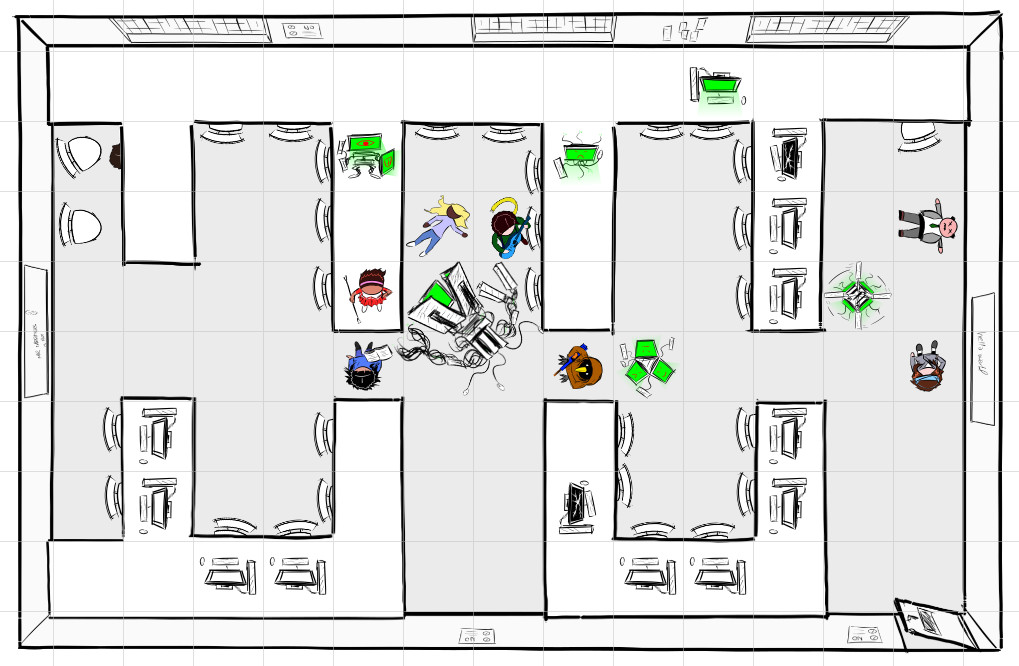
The first combat encounter was set in an IT classroom in which a magical computer virus caused the computers to come to life and attack people. I’ve always wanted to use modrons in an encounter ever since buying the Monster Manual, so this was my chance to do that.
I modified the modrons slightly so that two modrons could merge with each other to form a modron of the next level up. Every turn, the virus would spread from every infected computer or modron to all adjacent computers. The screen of an affected computer would glow green for one turn, after which it would transform into a modron.
3/4/2021
The Gizmo
If you play D&D with me, please don’t read this section!
The gizmo is a magic item that I gave one of the players in the third session. They had no idea what it did, so they never used it.
Many of the effects are genre-specific, but most of them could be fun in any setting.
Several of the effects might seem disproportionately weak/powerful, or unbalanced. For example, the “Simon Says” effect has a relatively lacklustre prize, and no upper limit on how long the effect can continue. This is intentional, and reflects the personality of the character who made the gizmo.
Gizmo
Wondrous item, legendary
The gizmo resembles a Rubik’s Cube made of copper and brass. Instead of coloured faces, each square has a small mechanical widget: a dial, gauge, lever, button, switch, etc. The gizmo is activated by manipulating one of these facets. Roll a d6 and a d10 and consult the tables below to determine the effect.
When a 10 is rolled, the gizmo transforms into a gun turret that fires indiscriminately at the closest creature every turn. A gun turret has an AC of 10 and 10 hit points. When it drops to 0 hit points, it turns back into the gizmo.
The gizmo can be thrown into a space immediately after a button is pressed but before the effect is determined.
Some facets produce items. Those facets remain empty until the items they produced are destroyed.
Some facets produce effects that require creatures to make saving throws. The DC for these saving throws is 10.
Some facets produce treats. Eating more than one of any type of treat, or eating more than three in one day may have a negative effect (e.g. the poisoned condition) at the DM’s discretion if a Constitution check is failed.
Unless otherwise stated, the gizmo’s effects have a range of 30 feet and last for one minute. Unless otherwise stated, effects that transform the gizmo revert when the transformed gizmo drops to 0 hit points. Dropping to 0 hit points while transformed does not destroy the gizmo.
Gizmo Effects
| d6 | d10 | Effect |
|---|---|---|
| 1 | 1 | They love me/they love me not. Choose a creature within range. That creature must make a Wisdom saving throw. On a failed save, roll a die. On an odd roll, the creature is charmed by you. On an even roll, it is frightened of you. |
| 2 | Truth or Dare. The gizmo selects a random creature within range. That creature must choose between “truth” or “dare”. The gizmo then casts zone of truth or suggestion on the creature, depending on its response. | |
| 3 | Would you rather? The gizmo selects a random creature within range. That creature must answer the question: “would you rather fight one (large creature)-sized (small creature) or a hundred (small creature)-sized (large creature)?” The DM fills in the specifics. The gizmo then summons hostile clockwork creatures depending on the creature’s response. Examples: weasel, rat, tarantula, owl, lion, bear, horse, elephant. | |
| 4 | Never Have I Ever. You may state something that you’ve never done. Any creature within range that has must either reveal that fact, or take 1d10 psychic damage and make a Charisma (Deception) check. | |
| 5 | Spin the Bottle. The gizmo selects two random creatures within range. Each of them must succeed on a Wisdom saving throw or be charmed by the other for one turn. | |
| 6 | Tell Me A Secret. You may reveal a secret to a creature within range that can understand you. That creature must reciprocate with a secret of equivalent importance. If the creature has no secrets, the gizmo explodes, and each creature within 10 feet must make a Dexterity saving throw or take 1d10 slashing damage. This destroys the gizmo. | |
| 7 | Seven Minutes in Heaven. Two random creatures within range are transported to one of the upper planes (for example, Mount Celestia) for seven minutes. Afterwards, they return to the space from which they left, or the nearest unoccupied space. | |
| 8 | Musical Statues. Music begins playing from the gizmo. After 1d4 rounds, the music stops. All creatures within range when the music stops have their speed reduced to 0 for one round. | |
| 9 | Simon Says. All creatures within range when the game starts are “in”. The gizmo issues a command every turn. Any creature that does not follow the command on its turn, or moves out of range, is “out”. When only one creature is “in”, that creature is the winner. The winner gains inspiration and 5 temporary hit points. | |
| 10 | Water. Range: 30-foot line. A creature hit by the water must succeed on a Strength saving throw or be pushed 10 feet away from the gizmo. | |
| 2 | 1 | Box of sweets. The gizmo opens to reveal ten boiled sweets in brightly coloured wrappers. Each sweet restores one hit point when eaten. |
| 2 | Lollipop. The gizmo opens to reveal a lollipop. The lollipop has ten charges. A creature can lick the lollipop as a bonus action, expending one of its charges. That creature benefits from the effects of the haste spell until the start of their next turn. On subsequent turns, if the creature does not lick the lollipop, it suffers a sugar crash. Its speed is halved, it is poisoned, and it can’t take reactions. The sugar crash lasts for a number of turns equal to the number of times it licked the lollipop, or until the creature licks the lollipop again. Once the lollipop’s charges are spent, it becomes a regular lollipop stick. | |
| 3 | Chocolate. The gizmo opens to reveal a heart-shaped chocolate. A creature who consumes the chocolate regards the next creature it sees as its true love for one hour. | |
| 4 | Candy cane. The gizmo opens to reveal an extradimensional space containing a candy cane the size and weight of a rapier. Its statistics are given below. | |
| 5 |
Rainbow sweets. The gizmo opens to reveal seven gumdrops, one for each colour of the rainbow. Each sweet bubbles when placed into the mouth and then explodes. The explosion can be controlled and used as a breath weapon that deals 2d6 damage or applies a status effect if a target fails the saving throw. Red. Fire, 30-foot cone, Dexterity. Orange. Acid, 30-foot line, Dexterity. Yellow. Lightning, 30-foot line, Dexterity. Green. Poison, 15-foot cone, Constitution. Blue. Cold, 15-foot cone, Constitution. Indigo. Restrained, Constitution. Violet. Blinded, Wisdom. | |
| 6 | Chewing gum. The gizmo opens to reveal a single piece of chewing gum. Chewing the gum for ten minutes provides enough nutrition to sustain a creature for one day. If swallowed, the gum remains in the stomach for 10 years, after which it is finally destroyed. | |
| 7 | Ice cream. A tap appears on the gizmo that can be used to dispense ice cream. It lasts until it is dismissed by pressing a button, or until it has dispensed enough ice cream to fill 20 cones. | |
| 8 | Round sweets that look square. The gizmo opens to reveal five square-shaped sweets. | |
| 9 | Cool mint. A compartment on the gizmo opens to reveal a mint. A creature who eats the mint is frozen in a block of ice for 1d4 rounds, during which time it is paralysed, unable to move or speak, and immune to all damage. The creature regains 1d6 hit points at the start of each of its turns while frozen. The ice has an AC of 10, 10 hit points, resistance to acid damage and magical piercing damage, vulnerability to fire damage, and immunity to all other damage. | |
| 10 | Candy Cannon. The turret has +2 to hit, and deals 1d8 acid damage. | |
| 3 | 1 | Fireworks. Fireworks erupt from the gizmo. Each creature within 10 feet must succeed on a Constitution saving throw or be blinded until the end of your next turn. |
| 2 | Grenade. A ball of flame engulfs the gizmo after two seconds. Each creature within 10 feet must make a Dexterity saving throw, taking 2d6 fire damage on a successful save, or half as much on a successful one. | |
| 3 | Dancing lights. Each of the gizmo’s faces begins glowing a different colour. The gizmo hovers two inches off the ground and rotates roughly in time with any music that is playing. If no music is playing, it rotates steadily. | |
| 4 | Laughing gas. Each creature within 15 feet must succeed on a Constitution saving throw or begin to laugh uncontrollably and fall prone under the effects of Tasha’s hideous laughter. | |
| 5 | Doves. 32 white doves fly out of the gizmo and into the air. | |
| 6 | Hole. The gizmo opens to reveal a portable hole, which looks like a black circle 5 feet in diameter. The hole can be placed on a flat surface, creating a portal to an extradimensional space of total darkness 10 feet deep. The hole can be removed from the surface and stored in the gizmo, trapping anything still inside the space. | |
| 7 | Balloons. A brightly-coloured button appears on the gizmo. Pressing the button causes the gizmo to inflate a helium balloon, which is attached to the gizmo with string. Up to 50 balloons can be created this way, enough to support the weight of a Large creature. The balloons slowly deflate over the course of 24 hours. The gizmo recharges at the same rate. | |
| 8 | Cleaner. The face of the gizmo retracts, and the gizmo begins to suck up dirt and grime. This can be used in a similar manner to the prestidigitation cantrip. | |
| 9 | Swap. In a puff of smoke, you and a random creature within range swap places with each other. | |
| 10 | Fire. Range: 15-foot cone. Creatures within range must make Dexterity saving throws, taking 2d6 fire damage on a successful save, or half as much on a successful one. | |
| 4 | 1 | Time stop. Time is frozen within 15 feet of the gizmo for 1d4 rounds. Creatures and objects within 30 feet of the gizmo have their speed halved for the duration. |
| 2 | Antimagic field. The gizmo casts antimagic field on itself. | |
| 3 | Tracker. The gizmo latches onto the closest creature or moving object, and drops a tracking device that can be used to locate it. A creature can spot the gizmo with a successful Investigation check. The DC for this check depends on the creature or object’s size class, and is 12 + 3 × the number of size classes larger than Medium. | |
| 4 | Rope trick. The gizmo floats ten feet off the ground and produces a ten-foot rope. It then disappears into an extradimensional space, acting like a casting of the rope trick spell. | |
| 5 | Reverse gravity. The gizmo reverses gravity in a 15-foot-radius, 30-foot-high cylinder around it, for 1d4 rounds. The area acts as if under the effect of the reverse gravity spell. | |
| 6 | Grappling hook. A 60-foot-length wire with a hook on the end shoots out from the gizmo. It attaches to the first surface it hits, and then retracts at a rate of 30 feet per turn. | |
| 7 | Alarm. A dial appears on the gizmo, allowing a creature to set a time or a duration up to 24 hours. At that time, or after that duration, the gizmo rings like an alarm clock. The gizmo also rings if any creature that was not in range when the alarm was set comes within range. | |
| 8 | Parachute. The gizmo sprouts straps and a parachute that prevent falling damage to a creature if it falls more than 60 feet through air. The straps and parachute detach when the creature lands. | |
| 9 | Silence. The area within 15 feet of the gizmo is silent for 1d4 rounds, as if the silence spell had been cast on it. The area of silence moves with the gizmo. | |
| 10 | Glue. The targeted 5-foot square of ground becomes difficult terrain. A creature attempting to leave the space must succeed on a Strength saving throw or have its movement speed reduced to 0 for the turn. | |
| 5 | 1 | Rockin’ horse. The gizmo produces a wooden rocking horse in the nearest unoccupied space within range. The horse has an AC of 10 and 10 hit points. It is friendly to you and your allies, and rock music emanates from it. The horse grants a d6 bardic inspiration to a creature within range each turn. It remains for one minute or until it is destroyed. |
| 2 | Action figure. The gizmo transforms into a clockwork action figure or toy soldier. At the start of each of your turns, the figure commands you to perform a random action (Attack, Cast a Spell, Dash, Disengage, Dodge, Hide, or Use an Object) for as long as it survives. Following its instructions does not cost you an action. It starts with 5 hit points and loses one at the end of each of your turns. It has an AC of 10. | |
| 3 | Dress-up doll. The gizmo transforms into a miniature wardrobe, inside which is a doll and several outfits. A creature can spend one minute dressing up the doll, after which equivalent clothes appear on the creature and grant advantage on one ability check it makes in the next hour, depending on the outfit (so a sporty outfit would grant advantage on an Athletics check, for example.) | |
| 4 | Doll’s house. The gizmo transforms into a doll’s house. The house and everything within it is fully functional, just very small. Very tiny creatures and those shrunk by magic could live happily within. The house contains enough food to sustain such creatures for a week. In the children’s bedroom of the house is an even smaller doll’s house. Attempting to interact with it transforms the doll’s house back into the gizmo, ejecting its occupants into the nearest unoccupied spaces. | |
| 5 | Spinning top. The gizmo transforms into a spinning top. When spun, it continues to spin for one round longer than any other spinning top within range, after which it transforms back. On its turn, it makes a melee attack against the closest spinning top within range, usually causing that top to stop spinning. | |
| 6 | Marbles. About 50 marbles fall out of the gizmo, turning a 15-foot square area into difficult terrain. A creature that enters a marble-covered space must make a Dexterity saving throw or fall prone. | |
| 7 | Jack-in-the-box. A crank handle protrudes from the gizmo. After the handle has been turned 1d8 times, a figure pops out. | |
| 8 | Duel Monsters. A secret draw slides out from the gizmo, revealing the five pieces of Exodia. | |
| 9 | Music box. The gizmo opens and plays music for 1 minute or until a creature uses an action to close it. When a creature moves into range or starts its turn there, it must succeed on a Wisdom saving throw or fall asleep. Regardless of the result, it is then immune to this use of this effect, and wakes up when it takes damage, when another creature uses an action to rouse it, or when the music stops. | |
| 10 | Nerf turret. The turret makes two attacks, has +2 to hit and deals 1d8 bludgeoning damage. | |
| 6 | 1 | Plot hook. The gizmo opens to reveal any hook (for example, a fishing hook). The hook has an air of mystery, and is deeply related to whatever the DM wishes to set up next. |
| 2 | Beholder’s eye. The gizmo opens to reveal a beholder’s eyeball and part of the eyestalk from which it was taken. A creature can use the eyeball as an action. Roll a d10 to determine which type of eyestalk it was from (see the Monster Manual for the various effects). The DC for any saving throw is 10, and the maximum damage a ray can do is 2d8. Inside the eyeball is a diamond worth 300gp, which can be detected with a successful DC 20 Investigation check. | |
| 3 | Stealth light. A secret drawer slides out from the gizmo. It appears to be empty, but in fact contains a glowing orb that emits bright light for 60 feet, and dim light for an additional 30 feet. The orb and the light it emits are only visible on the ethereal plane, and to those who have their eyes closed. | |
| 4 | Plot armour. The gizmo opens to reveal a ring bearing a shield design. A main character who wears this ring and no other armour cannot be reduced to 0 hit points. Any attack that would reduce them to 0 hit points is miraculously avoided. The ring disintegrates after it has been worn for 24 hours. | |
| 5 | Wild magic. The gizmo crackles and glows with magical potential. A wild magic surge occurs. | |
| 6 | Aura of the Protagonist. The gizmo opens to reveal a glowing golden liquid. A creature who drinks the liquid has the Aura of the Protagonist for one hour. During this time, they have +1 bonus to their Charisma score and they cannot obscure their face with hair, a helmet, or similar. Their face is always well lit, even in dim light. Any non-hostile NPC they come into contact with must succeed on a Wisdom saving throw or tell them their current problems. If they have no quests to offer, they must instead explain the history of the area, or provide other relevant exposition. | |
| 7 | Compass. A gauge on the gizmo contains an arrow that points north, or in a direction of the DM’s choice. | |
| 8 | Well of inspiration. The gizmo transforms into a miniature well that produces an effervescent pink liquid. A creature that drinks from the well gains inspiration. The well then runs dry for 1d4 weeks, after which the gizmo transforms back. | |
| 9 | Mysterious ticking noise. The gizmo makes an ominous ticking noise that stops after one minute. | |
| 10 | Web turret. The targeted creature must succeed on a Dexterity saving throw or be restrained by sticky webbing, which has an AC of 10, 5 hit points, and vulnerability to fire damage. A restrained creature can use its action to make a Strength check (DC 10). On a success, the webbing is destroyed. |
Cane of Candy
Weapon (rapier), rare
You gain a +1 bonus to attack rolls made with this magic weapon, which deals acid damage instead of piercing damage. The cane has 10 hit points, resistance to all damage, and is edible.
Whenever you would take damage, the cane takes half of that damage instead of you.
As an action, you can eat part of the cane to regain 1d6 hit points, reducing the cane’s hit points by 1.
It was a lot of effort for an item that was never used, but I’m sure I can find an opportunity to use it again.
6/4/2021
The Basketball Game
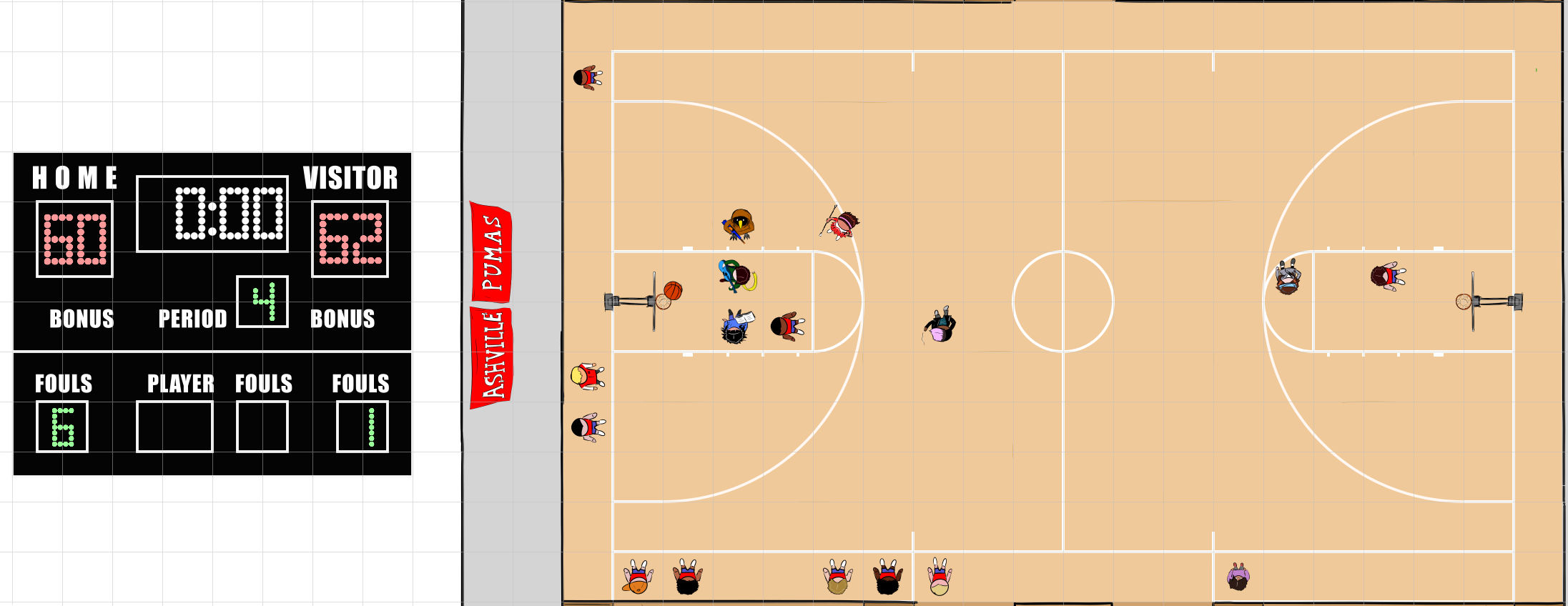
This was a fun encounter. They were against the clock here, with ten rounds to win the basketball game. They managed to pull into the lead on the final turn of the final round.
We used the rules for basketball I posted before.
Friendly NPCs
This seems like as good a time as any to show you the stat blocks for the friendly NPCs in the campaign.

Aeron
Medium humanoid (wood elf), lawful good
Armour Class 14
Hit Points 29
Speed 35 ft.
| STR | DEX | CON | INT | WIS | CHA |
|---|---|---|---|---|---|
| 10 (+0) | 14 (+2) | 8 (-1) | 15 (+2) | 14 (+2) | 16 (+3) |
Saving Throws Wis +5, Cha +6
Skills Insight +5, Perception +5, Persuasion +6, Religion +5
Senses darkvision 60 ft.
Languages English, Spanish, Mi’kmaq, French
Fey Ancestry. Aeron has advantage on saving throws against being charmed, and magic can’t put him to sleep.
Mask of the Wild. Aeron can attempt to hide even when he is only lightly obscured by foliage, heavy rain, falling snow, mist, or other natural phenomena.
Paladin. Aeron is a 5th-level paladin (Oath of Devotion) with the following class features: Divine Sense, Lay on Hands, Fighting Style: Protection, Divine Smite, Divine Health, Channel Divinity, Extra Attack. His spellcasting ability is Charisma (spell save DC 14, +5 to hit with spell attacks). Aeron has the following spells prepared:
1st level (4 slots): command, shield of faith, detect magic, detect poison and disease, protection from evil and good, sanctuary
2nd level (2 slots): locate object, lesser restoration, zone of truth
Actions
Multiattack. Aeron makes two Truth Bullet attacks.
Truth Bullet. Ranged Weapon Attack. +5 to hit, range 30/120 ft., one target. Hit: 6 (1d8+2) force damage.
Lay on Hands.
Channel Divinity: Sacred Weapon.
Channel Divinity: Turn the Unholy.
Reactions
Fighting Style: Protection. When a creature Aeron can see attacks a target other than him that is within 5 feet of him, he can use his reaction to impose disadvantage on the attack roll.
Aisha Shakoor
Medium humanoid (human), chaotic good
Armour Class 15
Hit Points 27
Speed 30 ft.
| STR | DEX | CON | INT | WIS | CHA |
|---|---|---|---|---|---|
| 11 (+0) | 17 (+3) | 13 (+1) | 9 (-1) | 16 (+3) | 14 (+2) |
Saving Throws Int +1, Wis +4
Skills Acrobatics +5, Athletics +0, Insight +4, Nature +1, Persuasion +2, Sleight of Hand +3, Survival +4
Languages English, Arabic, Druidic
Druid. Aisha is a 4th-level druid (Circle of the Moon). Her spellcasting ability is Wisdom (spell save DC 13, +5 to hit with spell attacks). Aisha has the following spells prepared:
Cantrips (at will): druidcraft, primal savagery, thorn whip
1st level (4 slots): cure wounds, entangle, ice knife, jump
2nd level (3 slots): moonbeam, pass without trace, warding wind
Catherine Wheeler
Medium humanoid (half-orc), chaotic good
Armour Class 17
Hit Points 44
Speed 30 ft.
| STR | DEX | CON | INT | WIS | CHA |
|---|---|---|---|---|---|
| 18 (+4) | 14 (+2) | 15 (+2) | 8 (-1) | 12 (+1) | 10 (+0) |
Saving Throws Str +7, Con +5
Skills Acrobatics +5, Athletics +7, Crochet +5, Intimidation +3
Senses darkvision 60 ft.
Languages English
Relentless Endurance. When Catherine is reduced to 0 hit points but not killed outright, she can drop to 1 hit point instead. She can’t use this feature again until she finishes a long rest.
Savage Attacks. When Catherine scores a critical hit with a melee weapon attack, she can roll one of the weapon’s damage dice one additional time and add it to the extra damage of the critical hit.
Fighter. Catherine is a 5th-level fighter (Battle Master) with the following class features: Fighting Style: Two-Weapon Fighting, Second Wind, Action Surge, Extra Attack. Her battle master techniques use Strength (save DC 15). She has four superiority dice (d8s), which can be used to perform the following battle master techniques:
Commander’s Strike. When you take the Attack action on your turn, you can forgo one of your attacks and use a bonus action to direct one of your companions to strike. When you do so, choose a friendly creature who can see or hear you and expend one superiority die. That creature can immediately use its reaction to make one weapon attack, adding the superiority die to the attack’s damage roll.
Menacing Attack. When you hit a creature with a weapon attack, you can expend one superiority die to attempt to frighten the target. You add the superiority die to the attack’s damage roll, and the target must make a Wisdom saving throw. On a failed save, it is frightened of you until the end of your next turn.
Trip Attack. When you hit a creature with a weapon attack, you can expend one superiority die to attempt to knock the target down. You add the superiority die to the attack’s damage roll, and if the target is Large or smaller, it must make a Strength saving throw. One a failed save, you knock the target prone.
Actions
Multiattack. Catherine makes up to three Fist attacks. (The third attack uses her bonus action.)
Fist. Melee Weapon Attack. +6 to hit, reach 5 ft., one target. Hit: 7 (1d6+4) bludgeoning damage.
Gordon was one of Hope’s dads. He was a Circle of the Land druid, but his domain was the city. I only worked out the domain’s spells up to 5th level.
Gordon Weissman
Medium humanoid (gold dragonborn), neutral good
Armour Class 12
Hit Points 35
Speed 30 ft.
| STR | DEX | CON | INT | WIS | CHA |
|---|---|---|---|---|---|
| 16 (+3) | 10 (+0) | 14 (+2) | 8 (-1) | 15 (+2) | 14 (+2) |
Saving Throws Int +2, Wis +5
Skills Athletics +6, Medicine +5, Perception +5, Persuasion +5
Damage Resistances fire
Languages English, Druidic
Druid. Gordon is a 5th-level druid (Circle of the Land: City) with the following class features: Wild Shape, Natural Recovery. His spellcasting ability is Wisdom (spell save DC 13, +5 to hit with spell attacks). Gordon has the following spells prepared:
Cantrips (at will): control flames, magic stone, mould earth, shape water
1st level (4 slots): create or destroy water, earth tremor, entangle, speak with animals
2nd level (3 slots): calm emotions*, darkvision, healing spirit, pass without trace*
3rd level (2 slots): stinking cloud*, tidal wave, tongues*
*domain spell.
Actions
Fire axe. Melee Weapon Attack. +6 to hit, reach 5 ft., one target. Hit: 7 (1d8+3) slashing damage.
Breath Weapon. Each creature in a 15 ft. cone in front of Gordon must make a DC 13 Dexterity saving throw, taking 2d6 fire damage on a failed save, and half as much damage on a successful one.
10/4/2021
Encounter 3: The House Party
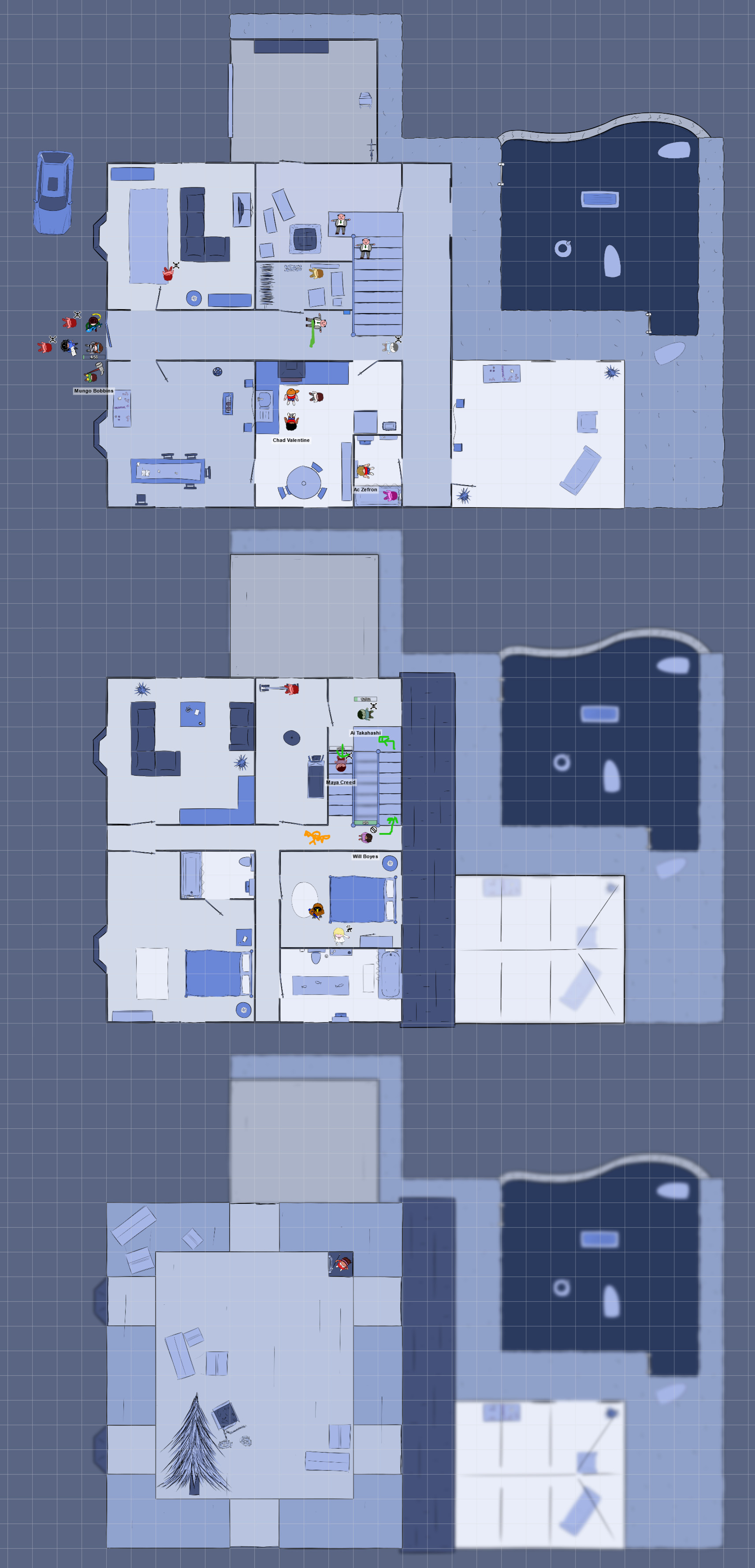
The idea behind the third fight was that the party would get caught up in an important situation and would need to think quickly and get as much information as they could to prevent something bad from happening. In this case, the vampires had an objective to complete (obtain Cordelia’s necklace), the werewolves wanted to stop them, and the player characters would hopefully get involved because they knew Cordelia and would want to prevent whatever the vampires were intending to do with her.
Unfortunately, this didn’t really work out. The encounter was split across two floors, with Cordelia and the vampire leader upstairs, and the rest of the vampires defending the staircase from the werewolves. I wasn’t clear enough about where the important stuff was happening, and the fact that I hid most of the map with fog of war didn’t help. For the first few rounds of combat, the players didn’t seem to have any interest in going upstairs. They mostly just attacked the vampires and the werewolves indiscriminately. In the end, I had Will go upstairs and get killed by a vampire to draw their attention, which felt clumsy and mean.
If I were to run this encounter again, I’d give them more information upfront about the situation, and I wouldn’t plunge the house into darkness at the start of combat.
Songs
This isn’t something I prepared for the campaign, but Marlowe’s player said that what he was doing at the party was playing the guitar, trying to explain Verfremdungseffekt to the tune of “Wonderwall”. I improvised the second line during the session and wrote the rest afterwards.
No Fourth Wall
Today is gonna be the day that I’m gonna spell it out and say
that by now, you should have somehow realised that it’s just a play.
I don’t believe that anyone should leave their brain behind outside the door.
Backbeat, the word is on the street that the fire in your art is out
And I’m sure you’ve heard it all before, but you’ve never really thought about
All of the lies that everybody feels they need to claim that theatre’s for.
And all the roads they lead you down are winding
And all the lights that light the stage are blinding
There are many things that I would like to say to you, so listen now
And think clearer
You’re gonna see some epic theatre
And after all,
There is no fourth wall
So think clearer
You’re gonna see some epic theatre
And after all,
There is no fourth wall.
The next one is one I had anticipated singing in the campaign, but when it came down to it, I didn’t have the confidence to sing more than a couple of lines. It’s the villain Titania’s song from before the final confrontation. The details were to be improvised based on the situation, but this was the general gist.
Queen of Your World
I’ve got medals and prizes aplenty,
I’ve got trinkets and trophies galore.
You want certificates? I’ve got twenty…
But who cares? No big deal. I want more.
I want to be where the people are.
I want them to see, them to see me dancing,
Strutting around on a big shining bright Broadway stage.
Ashville High won’t get me too far;
I’m gonna be, gotta be in New York—
Seeing my name in the lights, see me on the front page,
Down where they sing,
Down where they dance,
Down with the bright lights and the romance,
All eyes on me.
I ought to be
Queen of that world.
17/4/2021
Encounter 4: The Arcade
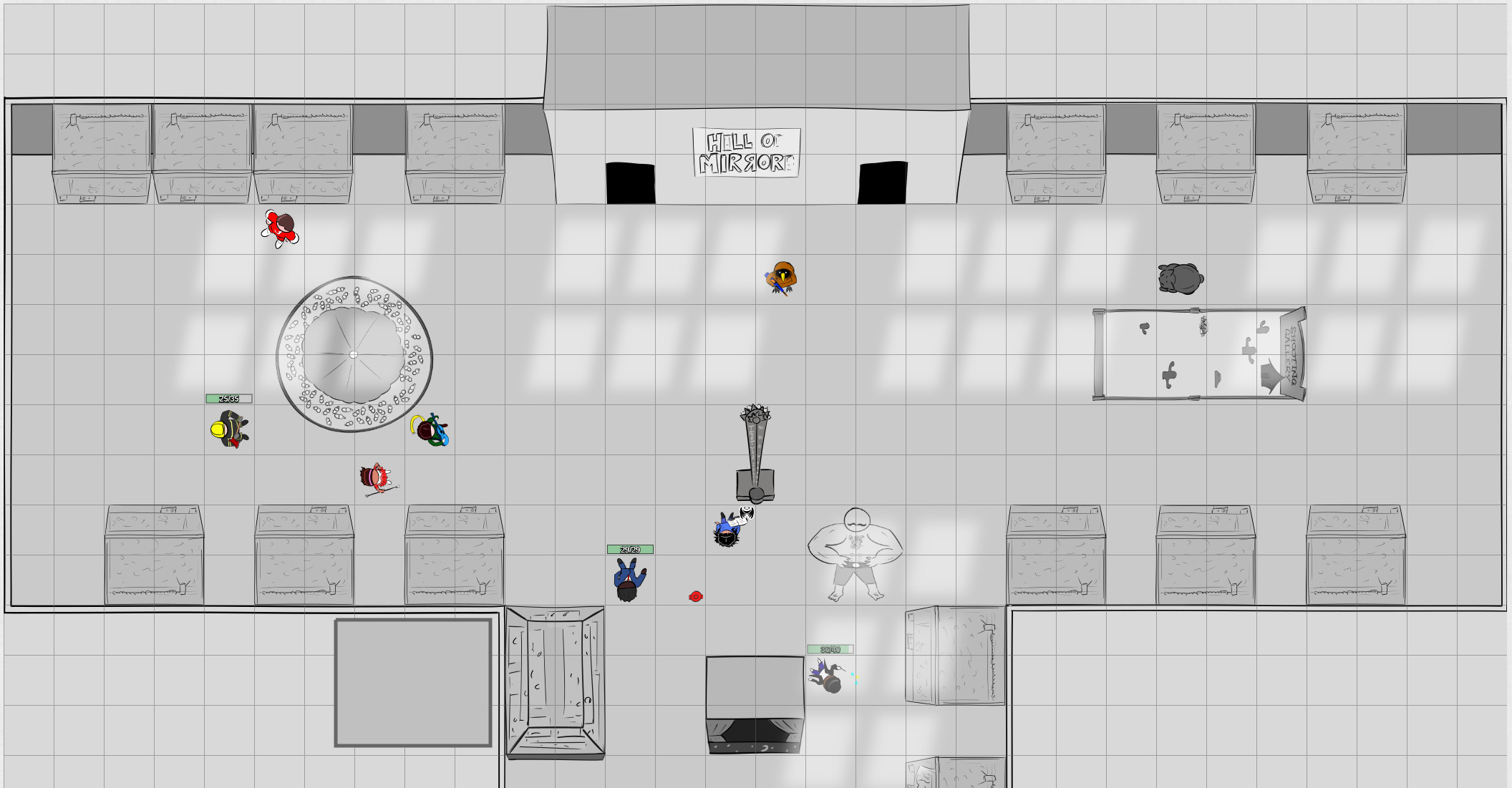
I ended up with less time to draw the map for this encounter, but I’m quite pleased with how it went. The main threat was the vampire called Niall Swordkiller, who was after Amber. He wanted to drink her blood and make her his thrall, giving him control over the source of all magic.
His partner in this fight was a magician, who was invisible for most of the fight.
The main gimmick of the fight worked well, though. In the centre was a “test your strength” attraction, with an image of a strongman behind it. At the start of the fight, thanks to the magician’s magic, the various attractions lit up and were rendered in colour, and the strongman came to life to fight the party.
The party could disable the strongman by “beating” the six attractions: the hook-a-duck, the hall of mirrors, the shooting gallery, the fortune teller, the coin pusher and the “test your strength” attraction. Each one contained a reward (one of the magic items listed above) and weakened the strongman.
It worked well overall. The minigames were simple and were resolved in one or two skill checks, but this was intentional, as I didn’t want the fight to drag on for too long (the previous two encounters had taken far longer than I had hoped).
Enemy stat blocks
Alright, here they are.

Anya Rider
Medium humanoid (human, shapechanger), neutral evil
Armour Class 14
Hit Points 120
Speed 30 ft. (50 ft. in wolf form)
| STR | DEX | CON | INT | WIS | CHA |
|---|---|---|---|---|---|
| 17 (+3) | 15 (+2) | 15 (+2) | 11 (+0) | 12 (+1) | 12 (+1) |
Skills Perception +4, Stealth +4
Damage Immunities bludgeoning, piercing, and slashing from nonmagical attacks not made with silvered weapons
Senses passive Perception 14
Languages English, Russian
Challenge 4 (1100 XP)
Keen Hearing and Smell. Anya has advantage on Wisdom (Perception) checks that rely on hearing or smell.
Pack Tactics. Anya has advantage on an attack roll against a creature if at least one of her allies is within 5 feet of the creature and the ally isn’t incapacitated.
Actions
Shapechanger. Anya can use her action to polymorph into a Large wolf or back to her true form. Any equipment she is wearing or carrying isn’t transformed. She reverts to her true form if she dies.
Multiattack. Anya makes two attacks. She uses her bite if she can, but only once per turn.
Bite. Melee Weapon Attack. +5 to hit, reach 5 ft., one target. Hit: 10 (2d6 + 3) piercing damage. If the target is a creature, it must succeed on a DC 13 Strength saving throw or be knocked prone. If the target is a humanoid, it must also succeed on a DC 12 Constitution saving throw or be cursed with werewolf lycanthropy.
Claws/Knife. Melee Weapon Attack. +5 to hit, reach 5 ft., one target. Hit: 7 (1d8 + 3) slashing damage.
Pistol. Ranged Weapon Attack. +4 to hit, range 100/400 ft., one target. Hit: 7 (1d10 + 2) piercing damage.
Audrey II featured in the final combat encounter, though I misjudged the difficulty of the encounter so didn’t use it to its full potential. It’s based on the shambling mound.
Audrey II
Large plant/construct, chaotic evil
Armour Class 15 (natural armour)
Hit Points 136
Speed 20 ft., swim 20 ft.
| STR | DEX | CON | INT | WIS | CHA |
|---|---|---|---|---|---|
| 18 (+4) | 8 (-1) | 16 (+3) | 5 (-3) | 10 (+0) | 5 (-3) |
Skills Persuasion +5, Stealth +2
Damage Vulnerabilities lightning
Damage Resistances cold
Condition Immunities blinded, deafened, exhaustion
Senses blindsight 60 ft. (blind beyond this radius) passive Perception 10
Languages English
Challenge 5 (1800 XP)
Actions
Multiattack. Audrey II makes two slam attacks. If both attacks hit a Medium or smaller target, the target is grappled (escape DC 14), and Audrey II uses Feed Me on it.
Slam. Melee Weapon Attack. +7 to hit, reach 5 ft., one target. Hit: 13 (2d8 + 4) bludgeoning damage.
Feed Me. Audrey II engulfs a Medium or smaller creature grappled by it. The engulfed target is blinded, restrained, and unable to breathe, and it must succeed on a DC 14 Constitution saving throw at the start of each of Audrey II’s turns. On a failed save, the creature takes 13 (2d8 + 4) bludgeoning damage and Audrey II regains that many hit points. If Audrey II moves, the engulfed target moves with it. Audrey II can have only one creature engulfed at a time.
Hercules Strongman
Large construct, neutral
Armour Class 13 (natural armour)
Hit Points 105
Speed 40 ft.
| STR | DEX | CON | INT | WIS | CHA |
|---|---|---|---|---|---|
| 21 (+5) | 8 (-1) | 19 (+4) | 5 (-3) | 9 (-1) | 6 (-2) |
Skills Perception +2
Senses passive Perception 12
Languages English
Challenge 5 (1800 XP)
Animated. Hercules loses 18 hit points whenever an attraction is won or destroyed.
Actions
Multiattack. Hercules makes two fist attacks.
Fist. Melee Weapon Attack. +8 to hit, reach 5 ft., one target. Hit: 18 (3d8 + 5) bludgeoning damage.
Mukta was based on the Mage stat block.
Magical Mukta
Medium humanoid (human), neutral evil
Armour Class 12 (15 with mage armour)
Hit Points 40
Speed 30 ft.
| STR | DEX | CON | INT | WIS | CHA |
|---|---|---|---|---|---|
| 9 (-1) | 14 (+2) | 11 (+0) | 17 (+3) | 12 (+1) | 11 (+0) |
Saving Throws Int +6, Wis +4
Skills Arcana +6, History +6
Senses passive Perception 11
Languages English, Hindi, Urdu, Arabic
Challenge 6 (2300 XP)
Spellcasting. Mukta is a 9th-level spellcaster. Her spellcasting ability is Intelligence (spell save DC 14, +6 to hit with spell attacks). Mukta has the following wizard spells prepared:
Cantrips (at will): fire bolt, mage hand, minor illusion, prestidigitation
1st level (4 slots): detect magic, magic missile, shield, silent image
2nd level (3 slots): mirror image, misty step
3rd level (3 slots): counterspell, dispel magic, fireball
4th level (3 slots): greater invisibility
5th level (1 slot): animate Hercules
Actions
Dagger. Melee Weapon Attack. +5 to hit, reach 5 ft., one target. Hit: 4 (1d4 + 2) piercing damage.
Mungo & Bungo Bobbins
Small humanoid (halfling), chaotic neutral
Armour Class 16 (studded leather)
Hit Points 59
Speed 25 ft.
| STR | DEX | CON | INT | WIS | CHA |
|---|---|---|---|---|---|
| 10 (+0) | 18 (+4) | 14 (+2) | 8 (-1) | 13 (+1) | 16 (+3) |
Saving Throws Dex +7, Int +2
Skills Acrobatics +10, Intimidation +9, Sleight of Hand +10, Stealth +10
Senses passive Perception 11
Languages English, Welsh, Thieves’ Cant
Lucky. When Mungo or Bungo roll a 1 on the d20 for an attack roll, ability check, or saving throw, they can reroll the die and must use the new roll.
Brave. Mungo and Bungo have advantage on saving throws against being frightened.
Halfling Nimbleness. Mungo and Bungo can move through the space of any creature that is of a size larger than theirs.
Naturally Stealthy. Mungo and Bungo can attempt to hide even when they are obscured only by a creature that is at least one size larger than them.
Ring of the Night. Mungo and Bungo both wear magic rings that grant them darkvision to a range of 60 feet.
Rogue. Mungo and Bungo are 8th-level rogues (Thief) with the following class features: Sneak Attack (4d6), Second-Story Work, Uncanny Dodge, Evasion.
Actions
Hamwise the Brave (Mungo only). Melee Weapon Attack. +7 to hit, reach 5 ft., one target. Hit: 11 (2d6 + 4) magical bludgeoning or piercing damage.
Multiattack (Bungo only). Bungo attacks twice: once with his fist and once with his dagger.
Fist. Melee Weapon Attack. +7 to hit, reach 5 ft., one target. Hit: 4 (1d8) bludgeoning damage.
Silvered dagger. Melee Weapon Attack. +7 to hit, reach 5 ft., one target. Hit: 8 (1d8 + 4) piercing damage.
Bonus Actions
Cunning Action. Mungo and Bungo can take a bonus action on each of their turns in combat to make a Sleight of Hand check; disarm a trap or open a lock with thieves’ tools; or take the Dash, Disengage, Hide, or Use an Object actions.
The final encounter: The Theatre
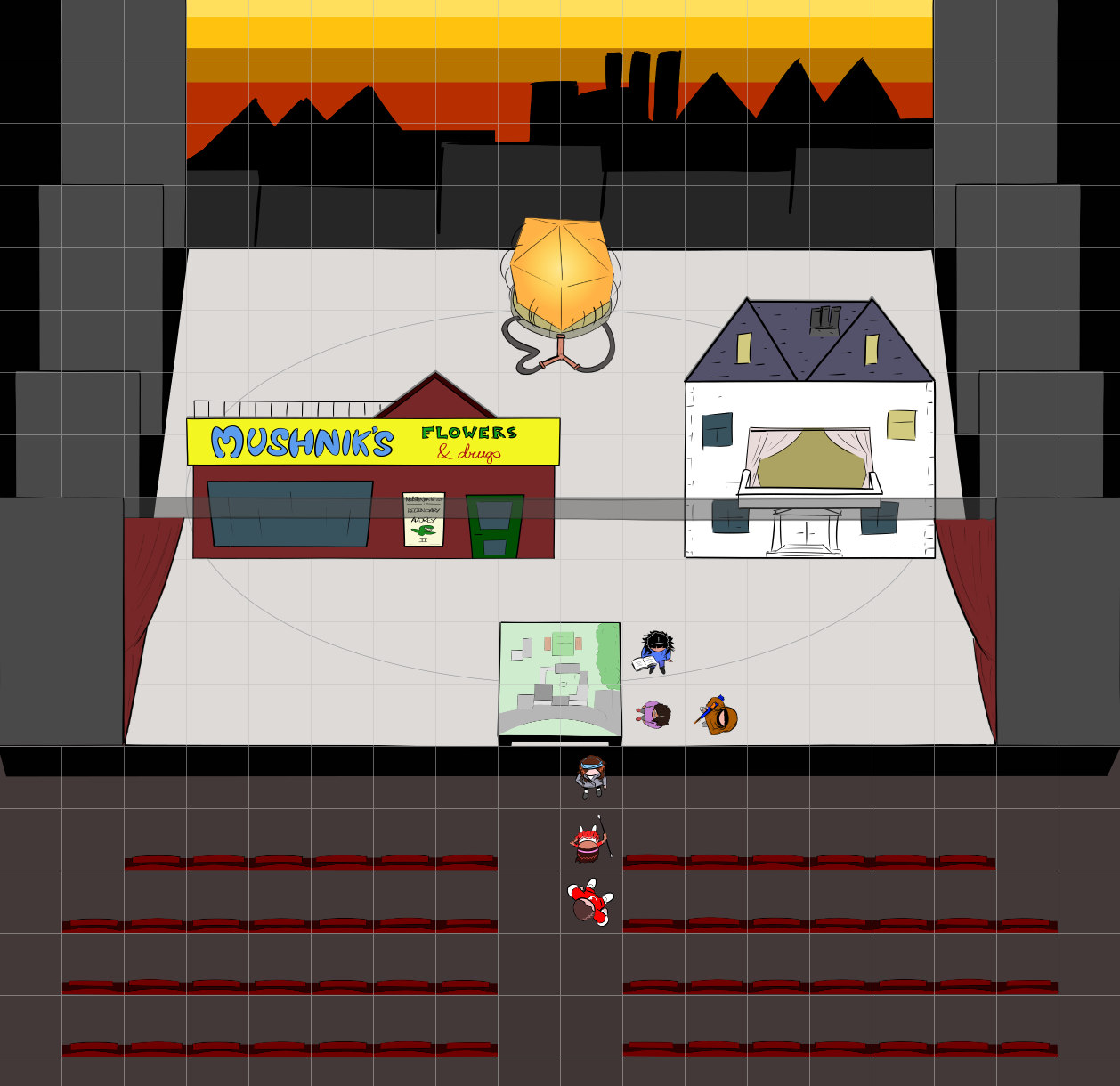
The final encounter took place in the school theatre. The party’s goal was to rescue Amber, who had been trapped in a fake world inside a crystal by Titania, Marlowe’s sister.
The set could change: as a lair action, Titania could rotate the set and bring the shop and the house together to form the barricade from Les Misérables.
This was the only encounter in which I had to reduce the difficulty on the fly. Most of the players seemed very reluctant to expend resources to try and leave the auditorium, despite the fact that it was dealing them significant damage every turn. I think I may not have been clear enough when describing the situation and their options.
Even with my on-the-fly adjustments (making Audrey II and Titania act a little less optimally), the fight was very close, with Marlowe and Will both dying, and nearly everyone dropping to zero hit points at one point or another.
Queen Titania
Medium fey, lawful neutral
Armour Class 17 (natural armour)
Hit Points 144
Speed 30 ft., fly 60 ft.
| STR | DEX | CON | INT | WIS | CHA |
|---|---|---|---|---|---|
| 10 (+0) | 18 (+4) | 12 (+1) | 15 (+2) | 15 (+2) | 20 (+5) |
Saving Throws Dex +10, Cha +11
Skills Deception +11, Nature +8, Performance +11, Persuasion +11
Damage Vulnerabilities bludgeoning, piercing and slashing damage from iron weapons
Condition Immunities charmed
Senses darkvision 60 ft.
Languages Sylvan, English, Spanish
Challenge 13 (10,000 XP)
Fey. Titania can’t be put to sleep by magic.
All Eyes On Me. Titania regains 20 hit points at the start of her turn if she is on stage, has at least 1 hit point, and there are no creatures downstage of her.
Legendary Resistance (3/Day). If Titania fails a saving throw, she can choose to succeed instead.
Spellcasting. Titania is a 9th-level spellcaster. Her spellcasting ability is Charisma (spell save DC 18, +10 to hit with spell attacks). Titania has the following spells prepared:
Cantrips (at will): shocking grasp
1st level (4 slots): healing word, shield, sleep
2nd level (3 slots): mirror image, misty step, suggestion
3rd level (3 slots): counterspell, fear, fireball
4th level (3 slots): greater invisibility, polymorph
5th level (1 slot): cone of cold
Actions
Multiattack. Titania makes two claw attacks.
Claw. Melee Weapon Attack. +9 to hit, reach 5 ft., one target. Hit: 8 (1d8 + 4) slashing damage.
Source of All Magic (recharge 5–6). While Amber remains trapped in the crystal, Titania can use her action to regain two spell slots of any level.
Legendary Actions
Titania can take 3 legendary actions, choosing from the options below. Only one legendary option can be used at a time and only at the end of another creature’s turn. Titania regains spent legendary actions at the start of her turn.
Move. Titania moves up to her speed without provoking opportunity attacks.
Claw. Titania makes one claw attack.
Lair Actions
Titania can use one of the following actions on initiative count 20 (losing ties). She can’t repeat an action until they have all been used, and she can’t use the same action two rounds in a row.
Willkommen. The auditorium becomes a cabaret until Titania loses concentration (as if concentrating on a spell).
The cabaret is difficult terrain. When a creature enters the cabaret for the first time on a turn or starts its turn there, the creature must succeed on a DC 15 Dexterity saving throw or take 3d6 bludgeoning damage and be restrained by spectral patrons until the effect ends. A creature that starts its turn in the area and is already restrained by the patrons takes 3d6 bludgeoning damage.
A creature restrained by the patrons can use its action to make a DC 15 Strength or Dexterity check (its choice). On a success, it frees itself.
Scene. The set changes between the town and the barricade. Creatures are pushed downstage by the set if necessary.
Could it be? Yes, it could. The second time this action is used, Audrey II appears.
That’s all! Thanks for reading!